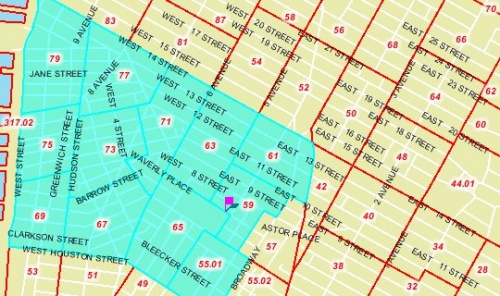Greenwich Village Demographics
From The Peopling of NYC
Greenwich Village is comprised of US Census Tracts 61, 59, 55.01, 69, 67, 73, 75, 79, 77, 63, 65, 71.
Contents |
[edit] Population
Greenwich Village has 64,355' residents as of the 2000 census, leaving the total area of the neighborhood at about 0.7 square miles. In 1940 the population was 44,428.
In assessing local needs it is necessary to understand what the increased shift in building use means to the community, and how the massive amount of new and bulkier construction has added, and will continue to add, more residents to a population count and neighborhood character not reflected in the 1990 census.
While figures from the 2010 census will not be available for sometime, the West and Central Village , from 1960 to 1990, had a population increase of twenty-two per cent (22%). In the Far West Village an area bounded by Hudson Street , the Hudson River , Gansevoort Street and Leroy Street – many large construction projects were completed in the last few years. Almost 1,000 new residential units were constructed at nine of these sites, in addition to other structures that are considerably larger than those in the area. New York University dormitory sites have also added thousands more people to the Community Board #2 area, and the New School is in the midst of its expansion program, as is Cooper Union. In addition, a private developer is proposing a massive development in Cooper Square .
According to a City Planning Commission report on the percentage change in 0-17 year old population; between 1980 and 2000, this district will have seen an increase that may approach 15% percent. This trend has already begun to manifest itself in increased numbers of children under five years of age in the SoHo and West Village neighborhoods of our district. There has also been a marked increase in demand for day care services and outdoor play space for this age group. While for-profit day care services are expanding to meet this demand, low-cost day care services do not have affordable space in which to expand. Our outdoor play space is extremely limited, and has reached the saturation point. Recently, the Children's Aid Society sold some of its outdoor playground space, which has placed an additional burden on our already over-used playgrounds. This critical need for outdoor play space brings additional urgency to this community board's insistence on the transformation of the Hudson River waterfront in the Greenwich Village area into a green, open space park.
This change in neighborhood character is not only dramatic but well documented: according to the New York Telephone Company, residential accounts have sharply increased in Community Board #2 while manufacturing accounts have declined.
Nevertheless, the New York City Administration continues to overlook the needs of our changed population, and has not provided the essential services to encourage a viable, safe, mixed use community for residents, businesses and tourists.
This information has been excerpted from the Community Board 2 website.
[edit] Age
 Most of the population are in their late twenties and early thirties, followed closely by those in their those in their forties. There is a relatively small amount of children, which is reflected by the small number of elementary and high schools in Greenwich Village.
Most of the population are in their late twenties and early thirties, followed closely by those in their those in their forties. There is a relatively small amount of children, which is reflected by the small number of elementary and high schools in Greenwich Village.
[edit] Race
[edit] Foreign Born
[edit] Education and Income
Close to half of the population has their BA, and a relatively large percentage also have their MA. Often those with higher levels of educations recieve higher salaries and that might be reflected in the higher rents in Greenwich Village. Those who work bagging groceries would not be able to afford them.
Similarly, the average income in 1960 was about $8, 862, almost doubling over the next decade to about $16,000. and still moving upward to $22.362 in 1980 and tripling to $69,750 in 2000.
[edit] Marital Status
 More than half of the population have never been married.
More than half of the population have never been married.
New Zoning Proposals from NYC Planning Department
NYC Health Statistics
Social Explorer Report
Source:
Home

